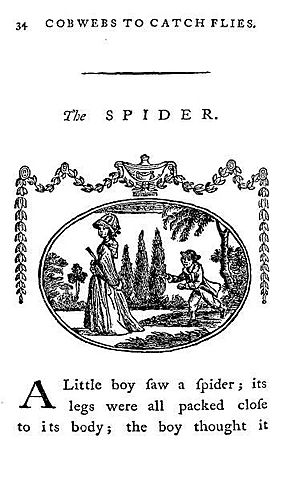Cobwebs to Catch Flies facts for kids
Cobwebs to Catch Flies is a famous children's book from 1783. It was written by Ellenor Fenn, though at first, her name wasn't on it. Later, the book was advertised as being by "Mrs. Teachwell" or "Mrs. Lovechild." This book was a special kind of reading primer, which is a basic textbook for learning to read. It was one of the first books to be made for different age groups of young readers. Cobwebs to Catch Flies was very popular and used widely until the 1890s.
Contents
What is Cobwebs to Catch Flies?
This book first came out in two parts. One part was for children aged three to five years old, and the second was for those aged five to eight. Later, these two parts were put together into one book.
The book is made up of many short, illustrated conversations between children. These conversations were designed to help kids learn basic reading skills. It was a very new and different kind of book for its time. It focused on things that children already knew and liked, such as their toys, pets, games, and even visits to the fair.
Why was it special?
Cobwebs to Catch Flies was one of the first books to offer different levels of reading for different ages. Each part of the book slowly became harder as the child got better at reading. The first versions of the book had large print and lovely woodcut pictures. Each volume also had a special engraved picture at the very front, called a frontispiece, which gave a hint about the stories inside.
How the Book Started
The author, Ellenor Fenn, first thought of Cobwebs to Catch Flies as part of a bigger and more expensive teaching program called 'A set of toys'. Copies of the book were given out with this program. However, Mrs. Fenn's publisher, John Marshall, soon realized that the book could be very popular on its own.
A Big Success
Cobwebs to Catch Flies became Marshall's most successful book. He printed many editions of it, keeping the book available all the time until about 1815. Over time, the pictures in these early editions started to look worn out, and the printing became less careful.
Later Versions of the Book
After John Marshall, the rights to the book were given to another publisher, Baldwin, Cradock, & Joy. They printed new versions of the book throughout the 1820s and 1830s. They made the books better quality and even had new pictures drawn for them.
The book was so popular that other printers copied it. For example, a printer in Dublin named John Rice made his own version in 1794. In 1799, Elizabeth Newbery, who was a rival to Marshall, published a French version of the book without pictures.
Spreading to Other Countries
Copies of the original book were also sent to the USA. There, different publishers made their own versions. These included Johnson & Warner in Philadelphia (in 1813 and 1814), E. J. Coale in Baltimore (in 1825), Mahlon Day in New York City (between 1832 and 1837), and C.S. and J.H. Francis in New York and Boston (in 1851).
Back in Britain, many other companies published the book. Darton and Co. printed several editions between 1842 and 1858. The Society for Promoting Christian Knowledge (SPCK) also published versions between 1844 and 1860, which they changed to include religious messages. Lockwood and Co. took over publishing in 1862.
Later, in 1870, a special edition with a colored picture at the front was published by Frederick Warne in London and Scribner, Welford, and Co. in New York. This version was printed again by Warne in 1894. Other publishers like George Routledge and Sons (1871) and Crosby Lockwood (1885) also released their own editions.
There was even a book that tried to be like it, called New cobwebs to catch little flies. This was published by the Religious Tract Society between 1833 and 1839.


